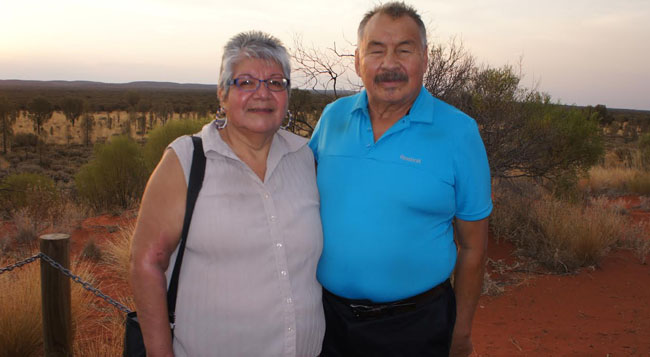Elder connected with the red earth down under

By Rick Garrick
ATIKAMEKSHENG ANISHINAWBEK — Whitefish Lake Elder Julie Ozawagosh recently discovered how sacred the land is near Uluru (Ayers Rock) in Australia during Muster 2014: Global Community Engaged Medical Education.
“What an awesome feeling – the land was so sacred,” says the Northern Ontario School of Medicine (NOSM) Elder who participated in two events at the Muster. “I was just putting my hand in that red earth and it was just amazing the connection that I got with that.”
Ozawagosh sang a song with rhythmic assistance from the local Anangu Aboriginal people to share her perspective as an Elder on the first evening of the Oct. 27-30 gathering at Uluru, which is located in the southern part of Australia’s Northern Territory.
“It was a kind of an international indigenous welcome to the conference,” says Dr. Roger Strasser, NOSM dean and CEO.
The Muster was the fourth conference hosted by NOSM and Flinders University School of Medicine, two in Canada and two in Australia, to bring delegates together to share, learn, develop and explore best practices in medical education and research.
“I spoke the Ojibwa language, and then I translated,” Ozawagosh says about her opening address. “All our land is sacred, so when you are walking on it and being there, it just has so much feeling, just walking on it and just knowing the earth is so different from ours.”
Ozawagosh also shared her perspective during a collaborative leadership plenary session with a physician and a panelist with a background in accounting. She has provided cultural perspectives and supports for many colleges, universities, communities and youth over the years and has more than 20 years of experience at the N’Swakamok Friendship Centre in Sudbury.
“I spoke from my heart,” Ozawagosh says. “With the three of us, I think it gave a whole different light of what we saw as being collaborative leadership.”
Strasser says the conference participants were “very touched” by the messages Ozawagosh brought and the stories she told at the conference.
“People were genuinely excited to have her there,” Strasser says. “We had a very strong Aboriginal and indigenous dimension to this conference.”
Strasser says that NOSM has made a distinctive mark on medical education since it opened in 2005.
“But global, community-engaged medical education is still emerging and there is still much to learn from each other,” Strasser says. “Muster 2014 provided yet another important opportunity to learn from each other and continue to mold global, community-engaged medical education for the better.”
Ozawagosh was intrigued to learn about the Anangu’s traditional healing practices, which are called “bush medicine” in Australia.
“They are more accepted when they do their work in their communities and in the hospital in the Alice Springs area,” Ozawagosh says. “They are very in demand, the men and the women.”
Ozawagosh says many of the Anangu healers practice healing with their hands.
“Some are gifted too as a seer,” Ozawagosh says.
Ozawagosh’s partner Frank Ozawagosh, who travelled with her to Australia, enjoyed learning about the land and different plants that are used by the Anangu.
“To me, the land is so important,” Frank says. “The different plants and herbs that (the healers) work with are so much different from the herbs and plants that we work with here in Canada. It was a great experience for me just to be able to go over there and be part of that and just walk on that land, because when I walk here on the land I really appreciate everything that is there.”
Julie enjoyed learning from the experiences of the other participants at the conference, including a wide range of physicians and medical students.
“I really didn’t know what to expect, but it was a trip we will never forget.”


